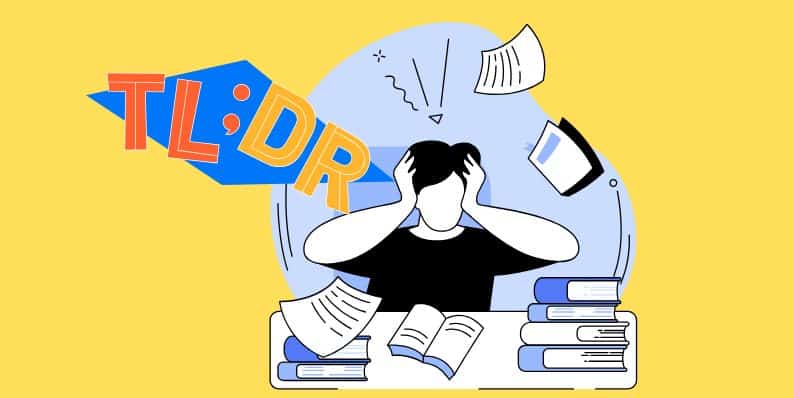A lot of people don’t read long posts anymore. They scroll fast and skip when they see big blocks of text.
That’s where TLDR helps. It gives the short version so you can get the point quickly without reading everything.
What Does TLDR Actually Mean

TLDR means “Too Long; Didn’t Read“. It started as internet slang, but now it's used across blogs, forums, emails, and social media platforms. It tells readers, “Here’s what you need to know.”
You often see TLDR in posts that are long or detailed. Writers put a TLDR at the top or bottom. It works as a quick content summary, helping people understand the key message fast.
The person who writes the post is usually the one who adds the TLDR. It’s meant to support the reader experience by giving the main takeaway. It’s not rude. It’s useful and thoughtful.
TLDR is part of how people read and write online. It supports fast content consumption, especially on platforms like Reddit, Twitter, and blog comment sections.
Where Do People Use TLDR the Most
TLDR appears across many digital platforms where long content is common and fast reading matters. It helps readers find key points without reading full blocks of text.
You will often see TLDR in:
- Blog posts
- Email replies
- Forum comments
- Discord, Slack, and messaging apps
It fits well in fast-moving places where people scroll quickly or join late in the thread. TLDR helps users catch up or decide if they want to read the full content.
Why TLDR Helps More Than It Hurts
TLDR is more than internet slang. It’s a smart way to make writing easier to understand. It supports better information delivery and respects the way people read online.
TLDR helps save time. Many users don’t finish long content. A summary gives them the answer quickly.
It also respects attention. With shorter focus spans and more screen time, TLDR helps the reader stay interested.
TLDR gives better clarity. It shows the message in one or two lines. That helps people get the point without guessing.
It improves content readability. When people see a TLDR, they are more likely to engage with the post.
It also invites more people to read. A clear summary can bring in busy users, mobile readers, or anyone looking for fast answers.
TLDR is not lazy. It’s part of smart communication. It fits well with SEO writing, content strategy, and user-first design.
How to Write a Good TLDR
Writing a TLDR is simple. You just need to share the core message of the post in a clear and short way. It should match the full content, not change the meaning.
Tips to write TLDR:
- Keep it simple
- Use clear words
- Put it at the top or bottom
- Don’t repeat everything, just the main idea
Examples:
- TLDR: I quit my job and started freelancing.
- TLDR: The update fixed the bug, but broke notifications.
Is It Okay to Use TLDR at Work
TLDR works well in workplace tools like Slack, Teams, or email chains. It helps coworkers get quick updates without reading the full message.
In casual messages, TLDR is fine. You can use it in chat updates, project check-ins, or team posts.
But in formal messages, like client emails or reports, it’s better to say “Summary” instead of TLDR. It keeps the tone professional while still being helpful.
- Example in a work chat:
TLDR: Task is complete, files are uploaded. - Example in a formal email:
Summary: All tasks are done. You’ll find the full report attached.
This keeps your communication clear and respectful in every setting.
When TLDR Isn’t the Right Fit
TLDR is helpful most of the time, but not always. Some situations need more care or detail. In those cases, skipping TLDR is the better choice.
Avoid using TLDR when:
- Writing to teachers, clients, or managers
- The full message is already short
- It could sound dismissive or too casual
- Full detail is needed for clear understanding
Always think about your reader. Use TLDR where it helps. Skip it where it feels out of place.
TLDR vs Summary — What’s the Difference
Both TLDR and Summary give the short version of a message. But they feel different and work in different places.
TLDR:
- Internet slang
- Used on Reddit, blogs, chat apps
- Good for fast summaries in casual posts
Summary:
- Formal word
- Used in work emails or school writing
- Sounds more polite and serious
Pick the one that fits the person you're writing to.
Fun and Memes — TLDR in Internet Culture
TLDR is also used for fun. People make jokes with it or add it to memes.
You might see:
- TLDR: I messed up
- TLDR: ok
It’s become part of how people laugh at long stories or over-sharing online.
Conclusion
TLDR is a small thing that makes a big difference. It helps people read faster, understand better, and save time. When used well, it makes your message easier to read and more likely to be shared.
Try using a TLDR in your next long post or message. It could be the part your readers remember most.




